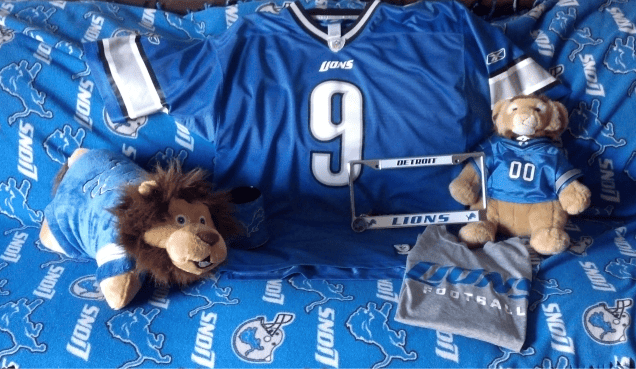
It’s Thanksgiving season, that time of year where many of us will be sitting down to way too much food, spending time with family, maybe playing some games, and if you’re like millions of other Americans, watching some football. I have two passions in my life outside my family and friends. One, as you all know, is board games. The other is Detroit Lions football!

I know what you’re saying, “Wait, this is supposed to be a tabletop game blog. Why are you talking to me about football?” There are two parts to that. One is that football is by far and away the most popular game in America (not the world, then we’d have to talk about that other football. You know, the one where you actually do kick the ball with your feet.) Consider some of these facts:
IN 2013, THE AVERAGE NFL GAME HAD 17.6 MILLION VIEWERS.
205 MILLION PEOPLE WATCHED AT LEAST ONE NFL GAME IN 2013.
111.3 MILLION PEOPLE WATCHED THE 2014 SUPER BOWL
19 MILLION PEOPLE ARE PLAYING FANTASY FOOTBALL RIGHT NOW
And this doesn’t even begin to go into high school and college football, both of which are extremely popular as well. This all brings me to the second part to my answer. What makes football so popular, what are they doing right? I have long believed that game designers can learn a lot from the sport of American football. In fact it was on my list of “Top Ten Games Every Designer Should Play”. So, I want to write to you about what a designer can learn from football. And I hope that you can incorporate some of these principles into your own game design.
1. SMALL, ACHIEVABLE IN-GAME GOALS
The whole point of every play in football is to get a first down. Teams have 3 downs (or plays for those not at all familiar with football) to try to gain 10 yards on the field. If they do gain those 10 yards they get a fresh set of downs and a chance to gain 10 more yards. If they fail, the ball goes to the other team.
This sets up a scenario where the team is moving in small chunks down the field toward a bigger goal (the endzone for a touchdown). The reason this is such a brilliant mechanic is that it constantly motivates players and coaches by giving them something achievable, a goal that they can easily see. All they have to worry about on every play is just getting 10 yards.
How can you apply this to game design? Try to give your players small goals that maybe give them just a few victory points or some resources. If you make everything in your game about getting a bunch of victory points at the end, you could lose players midway through the game. They will lose motivation because the goal is too far off.
2. ABILITY TO REACT INSTANTANEOUSLY TO WHAT YOUR OPPONENT DOES (I.E. PLAYING DEFENSE)
One of the key components of football is that the defense can control the outcome of the game just as much as the offense. Some teams cannot seem to score much but all they really have to do is keep their opponents from scoring to actually win the game. If any game is dominated too much by offense (no one can keep anyone from scoring) or defense (no can score at all) it is not that exciting of a game. But when teams are balanced in both defense and offense it makes for a really exciting game.
In your game design, give your players a chance to thwart or at least slow down the active player. If a player has an opportunity to do something even when it’s not their turn, it can make for a more exciting game overall. Of course you will have to keep that concept of balance in mind. You won’t want a game where everything any player tries to do is thwarted immediately, but you also don’t want a multi-player solitare game where no one has any chance to affect what their opponents are doing.

Leaguers Jeff and Luke at a football game. I believe Luke’s response was “Go Football!”
3. REAL TIME SENSE OF URGENCY
A really intense time in a football game is when there is less than 2 minutes left on the clock, your team has the ball, and they have to drive 80 yards for a touchdown to win the game. There is this tense excitement in the air as they try to beat not only the other team but the clock as well. There are rules put in place that allow them to have some advantage over the clock (timeouts, clock stops on out-of-bounds, etc) but it comes down to how they manage those various elements to determine if they will win the game in the end.
How can you incorporate this same type of sense of urgency in your game design? There are real-time games that can do this somewhat. Is there a way to do this in a non-real time game? I have seen some co-op games that do this pretty well. As you design think about the situation in your game, both in the beginning and at the end. Does your game start fast? Does your game seem to limp its way to the end game or does the action build all the way up till the end of the game and make for an exciting finish?
4. HALF TIME ADJUSTMENTS
The game of football has a break right in the middle of the action called half-time. Teams will go into the locker room, get some refreshments, cool off, and talk about what is happening in the game. I have seen many games where the team coming out after half time looks like a completely different team. While they couldn’t seem to score at all during the first half, all of a sudden they can move the ball at will the second half. This comes from giving the players and coaches time to evaluate what the other team is doing and change their strategy a bit.
This can be incorporated into your game design by giving your players a chance to modify their strategies mid-game. I am not suggesting that you design in a break where everyone quits playing, but give players options. You don’t want a player’s first 2 moves to dictate what their strategy will have to be the rest of the game. Try to design so that changing strategy mid-way through can be a valid move and may even help win the game.
5. TRICK PLAYS
And finally, one of the most exciting parts of any football game is when something happens that you don’t expect. Every team has in their arsenal a fake punt, or a reverse, or a pass by the running back or some other play that you wouldn’t normally expect. Teams don’t use these very often, maybe only once or twice per season. They whole idea is that if they can catch their opponent off-guard they can accomplish something great.
I believe there is a place for surprise and trickery in game design. Again, it shouldn’t happen all the time, but it can make a game fun and exciting to have the thing you least expect actually happen. The design challenge here is to figure out how to include these kinds of surprise elements so they happen infrequently but yet provide a fun experience for the players.
I hope this has helped give you all another perspective on game design and hopefully you will check out some football this Thanksgiving to see what you can learn. What other elements of football (or other sports/non-tabletop games) can you think of that would make for great game design?








